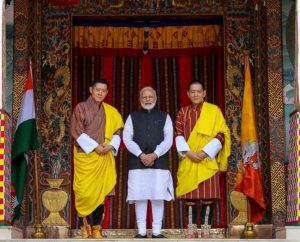
There is no doubt that we live in a perilous age. Global conflicts seem to arise almost daily, each one brought to our overtaxed attention by media drowning in a sea of information, shackled by market pressures, and weighed down by outmoded visions of reality. Around the globe, the pillars of journalism are faltering and scrambling to adapt to the quickly changing world. Many are cutting back on veteran writers, others are eliminating local news.
At the same time, citizens believe that they are “curating” their own newsfeeds, either through social media accounts or news aggregators. Behind the scenes of each major social media site, however, is a company working first and foremost to drive its own profitability upward. In this, many people do not realize that what they are seeing as “news” is often delivered to them not for the intrinsic value of its content, but for the profit it can make a publisher or media platform.
What can a Buddhist moral imagination offer?
In his latest book, The World Could be Otherwise: Imagination and the Bodhisattva Path (Shambhala 2019), Zen teacher Norman Fischer gives us direction.
Fischer notes that Karl Marx called religion the opium of the people, and yet Marx also wrote that religion is “The heart of a heartless world.” Empathizing with Marx, Fischer notes that religions can too easily become machines of oppression and yet, he suggests, “Even at its worst, religion has a glowing coal of wildness hidden in its contemplative, mystical side—in texts, teachings, practices, and experiences that come from the uncharted expanses of the human imagination, religion’s heart and soul.” (Fischer 5-6)
Imagination, Fischer offers, is the faculty of the mind that expands beyond the borders of our current reality. He points here to the Prussian philosopher Immanuel Kant (1724–1804), who took imagination to be “central to human consciousness, literally creating the world we perceive and live in.” (Fischer 7) This was in contrast to a theory of knowledge wherein our knowledge represents an actual world out there. For Kant, the direct representation theory was naïve, and Fischer points out that contemporary cognitive science confirms Kant’s insight that consciousness is creative.
The contemporary philosopher Mark Johnson likewise writes, “We human beings are imaginative creatures, from our most mundane, automatic acts of perception all the way up to our most abstract conceptualization and reading.” (Johnson ix)

If we limit ourselves to this world in which reality is simply whats out there, then we abandon the power of our own imagination, we live in the realms of causality known in early Buddhism as utu-niyama (material causality) and bija-niyama (organic causality). In Buddhist thought, these are surpassed by kamma (action/morality), dhamma (truth, reality), and chitta (mind). Without seeing these higher levels of causality as part of our worlds, we may be drawn into mere hedonism and materialism.
“The Pali word for sense faculty is indriya, a very interesting word that reveals much about our human situation. Indra means lord or king, and the sense faculties are called indriyas because they dominate us so much. They act as our lords or masters and we slavishly obey them. The eye wishes to see pleasant forms, the ear wishes to hear pleasant sounds . . . the six senses are constantly seeking gratification in their own spheres, and the man who has no control over his sense faculties becomes terribly confused,” writes the late Dr. Lily de Silva. (Accesstoinsight)
As we have seen in many critiques of the commodification of Buddhism in the West through the popularization of mindfulness teaching, Buddhists and others are quite capable of such confusion, and abandoning morality and thought of the ultimate goal of awakening.
Asia is not left out, of course, as a recent article on the realpolitik of Nepali Buddhism describes, “Everyone is instrumentalizing Buddhism—Nepal, Burma, Sri Lanka, Thailand, but, most prominently, India and China,” said Oxford professor of Nepali history David Gellner. Competition to control major Buddhist heritage sites is fiercest in Nepal, where the political consequences—specifically with regard to Tibet and the succession of the Dalai Lama—are most significant. (The Diplomat)

The task of imagination is to rebel against this materialistic reduction, this instrumentalization of Buddhism. Yes, Buddhism has always and will always have a role to play in political discussions, and we might rightly celebrate the fact that major world leaders are discussing and at times promoting the religion. Even more promising is when the ideals of Buddhism find their way into policies that improve people’s lives, offering freedom from suffering and opportunities for further development.
However, the purpose of Buddhism lies, as Fischer points out, not in its political power but in experiences that come from the uncharted expanses of the human imagination. As he explains, Buddhism begins in the human experience of suffering, and the whole of the Buddhist path is one continuous circling back to this truth: we suffer. But in that process, awareness deepens and sight clarifies, allowing us to see through the illusory forms of happiness that keep us desiring the mass consumption of material goods. Seeing our underlying desires, sometimes rather suddenly, sometimes bits here and there, leads us to shift toward another desire: that for awakening itself.
Desire is how we take our place in the causal matrix of space and time. The only thing not rooted in desire is nirvana, for it’s the end of all phenomena and lies even beyond the Buddha’s use of the word “all.” But the path that takes you to nirvana is rooted in desire — in skillful desires. The path to liberation pushes the limits of skillful desires to see how far they can go. (Bhikkhu Bodhi, Access To Insight)

Our moral imagination turns us thus away from what is, so that we can give space for what might come. Artists, such as Kim Dembrosky, can shake up our indriya, our faculties, with bold expressions such as the one here, echoing the bodhisattva’s vow to be of service to all sentient beings. What does that look like? The very attempt to manifest a vision tears us away from the obsessions of our day-to-day lives. A better world? How? In what ways can I, must I, be a part of that world, stepping out of this one?
In these perilous times, poets, philosophers, and artists can help engage our imaginations in ways that unbind us from repetitive cycles of desire, opening the possibilities of moral self-reflection, development, and service to others. This is, to borrow from Fischer’s book title, the good news of Buddhism, that the world could be otherwise.
References
Fischer, Norman. 2019. The World Could Be Otherwise: Imagination and the Bodhisattva Path. Boulder, Colorado: Shambhala Publications Inc.
Johnson, Mark. 2014. Moral Imagination: Implications of Cognitive Science for Ethics. Chicago: University of Chicago Press.
See More
Local News Is Dying, and Americans Have No Idea (The Atlantic)
China Is Winning the War for Nepali Buddhism (The Diplomat)
One Foot in the World: Buddhist Approaches to Present-day Problems (Access to Insight)
The Quest for Meaning, by Bhikkhu Bodhi (Access to Insight)














